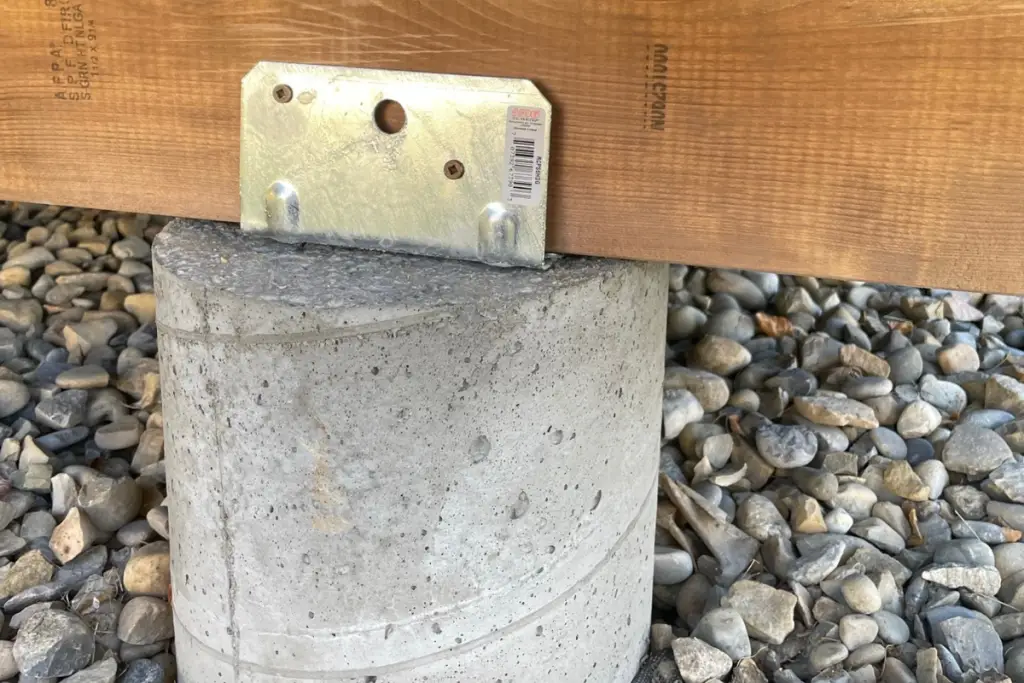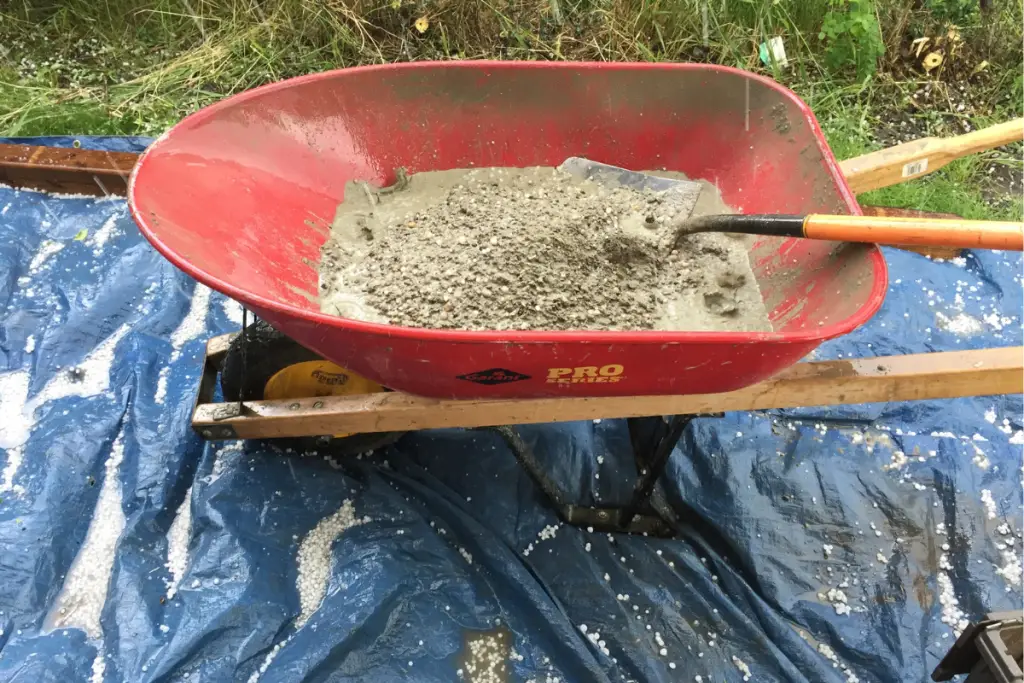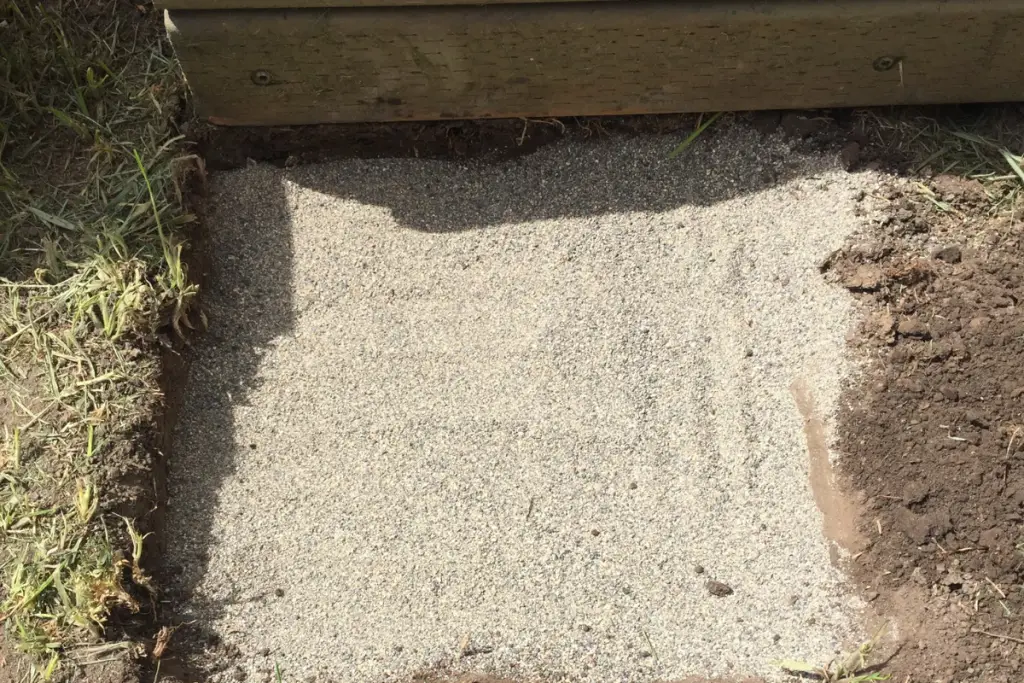When it comes to building a deck, homeowners must decide between using pier blocks or concrete footings. Pier blocks are easy to install and ideal for smaller decks built at or near ground level, while concrete footings require more labour but provide greater strength and stability for your deck.
Consequently, the choice of which one is best depends on factors such as the size and height of your deck, ground conditions and soil type.
We will explore the differences between pier blocks and concrete footings to help you decide which one is right for you while building your deck.
Overview of Deck Pier Blocks and Concrete Footings
Deck pier blocks are pre-formed concrete blocks designed to support low decks. Often designed with a hole in the center of the block to hold a post or cross shape area to support the deck beam/joist directly.
They are lightweight and easy to install, requiring minimal digging and no mixing of concrete.
Best suited for small ground-level decks less than 24″ from the ground.
Concrete footings, on the other hand, require additional labour and cost. The concrete is mixed on-site and placed in concrete forms dug to below the frost level.
Footings provide greater support than pier blocks being dug into the ground and set below the frost level minimizing seasonal deck movement.
What to Consider when Choosing Between Deck Blocks or Footings
There are 2 main things to consider when deciding which deck support is best for your deck.
- Height of the deck
- Soil bearing under the deck
- Grade of the ground under the deck
- Location of the deck
What height will your deck be?
Deck Blocks are only acceptable for decks not requiring frost footings. In most states, that is any deck lower than 30″. In Canada, 24″.
So if your deck is not a ground-level deck, you will need to dig frost-level concrete footings.
Is the soil load-bearing?
Clay and sand are excellent load-bearing soils. The worst is loam, commonly referred to as topsoil. It absorbs water, making it unstable under your deck pier.
In most cases, you can replace the loam with compacted gravel or sand before placing the deck pier, and you are good to go.
before placing the deck pier, and you are good to go.
But I have built decks in areas where the loam was a few feet deep. To ensure the deck was sufficiently supported and wouldn’t shift, we dug down and pour concrete footings. Overcoming the unstable soil.
Does the area have a steep slope?
There are two main reasons why not to install deck blocks on a slope.
- A steep slope may elevate one end of the deck beyond 30/24″, requiring the deck to have frost footings.
- The second reason is safety. If the slope is too steep, it could make the deck block unstable as its more prone to shifting and sliding down the hill.
In these cases, concrete footings are better for optimal support and stability.
Is the deck attached to your house?
In most jurisdictions, any decks attached to a building must have frost footings.
So if your deck is supported by a ledger on your house, grab the shovel you will need to dig frost footings.
Advantages of Using Deck Pier Blocks
It is relatively easy for an individual to install deck blocks by themselves. Most deck pier blocks will weigh around 50 lbs, roughly the same amount as a bag of concrete.
Not being dusty concrete mix, you can also pick them up in your car a the store without making a mess in the back seat.
Avoid the hassle of on-site concrete mixing by eliminating it altogether.
This is super important when working in a finished yard. You don’t want concrete dust on your wife’s prized flowers.
Or accidentally having the wheelbarrow tipping, spilling concrete on your manicured lawn.
Deck blocks are more economical than poured concrete footings. For less than the price of 2 bags of concrete, you can buy a deck pier and start building this afternoon.
Installing pier blocks will significantly save you time and work than pouring concrete. The biggest savings are in prep or the lack thereof. No spending hours digging holes, hauling out a tarp, wheelbarrow, shovel and garden hose for mixing concrete.
A simple shovel to remove the loam, compact the gravel and start building.
Can be installed around tree roots. Stretching out on your deck under the shade of a tree is paradise. But if you have to cut through tree roots to build your deck, that shade might not be there to enjoy if the footings kill the tree. With deck pier blocks, no roots have to be cut to install.
Disadvantages of Using Deck Pier Blocks
There are some disadvantages to using deck pier blocks compared to concrete footings.
- No positive connection between the deck and the footings. Making it easy for the deck to be moved of the footings. Yes, the weight of the deck will generally hold the deck down, but a strong wind storm or accidentally overweighting one side can cause the deck to tip.
- Most pier blocks from your local building store do not contain rebar reinforcement. Impact force can crack and break the footing.
- Limit applications. Such as a raised or attached deck where deck blocks are not suitable.
Advantages of Using Concrete Footings
There are four key advantages to concrete footings for your deck.

- Concrete footings provide greater support for decks being supported by the ground that is not prone to seasonal shifting. Freeze, thaw cycle.
- Additionally, concrete footings can be increased in size depending on the load bearing of the soil. Being dug into the ground, they can also provide lateral support for the deck posts. In most cases, the post should not be set in the concrete but secured with a post saddle, but lateral bracing can be run between posts to increase the stability of the deck.
- Positive connection anchoring the deck down. With concrete footings dug into the ground with post saddles. The deck beam is anchored to the post saddle, and your deck is not going anywhere. Preventing the potential for uplift and minimizing lateral movement.
- Meets most local jurisdictions’ building codes. For the above reason and more , concrete footings typically meet most local building codes. Therefore are often required.
Disadvantages of Using Concrete Footings
The main disadvantage of concrete footings is the additional labour and cost involved in their installation. This includes having to dig deep holes for each footing, mixing on-site concrete and using pre-made forms to set them in place.

You will also need to dispose of the dirt dug out from the holes. Either raking it out under the deck area but ensuring still to provide the correct grade under the deck. Or hauling the dirt away.
Also, unlike precast deck piers, which you can start building on immediately, fresh concrete will need time to set up before building off.
Delaying deck construction.
How to Install Deck Pier Blocks
It’s the base under the deck blocks that makes all the difference. Good base equals good support.

- Dig out the topsoil and level the ground where the deck block will sit. It is essential to remove all organic material as this will make the block unstable.
- Place about 2″ (50mm) of non-organic drain material in the hole and compact. This is to provide drainage under the deck block to minimize heaving. The water draining away and space between the rocks provided room for the ice to form without moving the block.
- Place the deck block and level with a two-foot or torpedo level. Add or remove base material to level the block as required. Make sure to compact before setting block to minimize shifting later.
- Now that was easy!
Final Thoughts on Which Option Is Best for Your Project
When it comes to building a deck, pier blocks and concrete footings, each have their own advantages and disadvantages.
Pier blocks are more economical than poured concrete footings, are easier to install, and can be used for smaller ground-level decks built around tree roots without cutting them.
However, they lack a positive connection between the deck and footing, which could cause the structure to move in strong winds or if too much weight is applied on one side.
On the other hand, concrete footings provide greater support for decks being supported by the ground not impacted by seasonal shifting but require additional labour and cost due to having to dig deeper holes for each footing as well as mix on-site concrete.
Ultimately which option you choose will depend upon your project size, soil type/ground conditions, budget and any special requirements such as lateral bracing or post saddles needed for the stability of the entire structure.
It may be best to speak with your local building department or contractor to determine which option is the best for you.
For a full step-by-step guide on how to build a floating deck . Click the link.
. Click the link.
